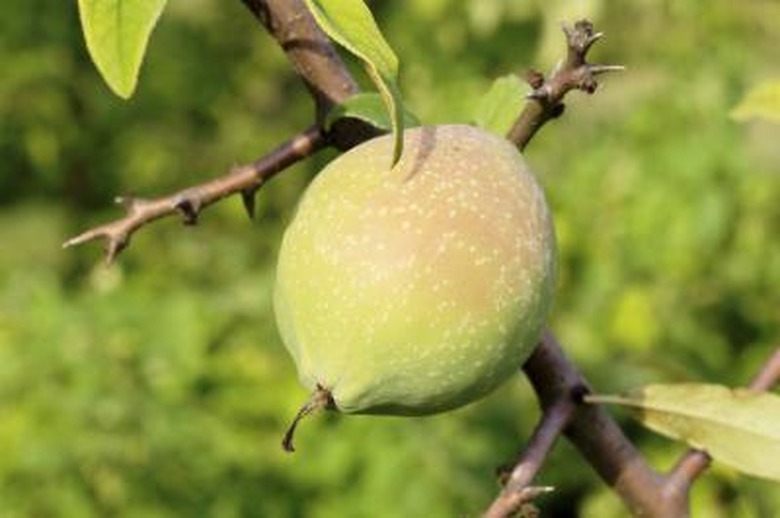What Fruit Trees Have Thorns?
We may receive a commission on purchases made from links.
Thorns often make you think of bushes, like raspberry bushes, but several types of fruit trees also grow thorns. Thorns on a plant protect it from the ravages of unfriendly, hungry fauna. Over the years, botanists have propagated fruit trees to discourage the growth of thorns since they typically grow in a home orchard where they don't need as much protection. However, some fruit tree species still have thorns.
Tip
Some fruit trees have thorns on them, depending on the species. Examples include lemon, orange, wild apple, thorn apple, pomegranate, wild plum, wild pear, and honey locust trees.
Lemon Fruit Trees
Lemon Fruit Trees
Lemon trees (Citrus limon) have thorns to protect the young trees. You may not think so, if you have a tree carefully propagated over generations to eliminate the unfriendly aspects and encourage larger, more flavorful fruit. Many species, such as the Eureka dwarf lemon tree (Citrus x limon 'Eureka'), are nearly thornless, which makes lemon trees easier to maintain. However, even the most "cultivated" lemon tree may have a thorn or two, hidden among the greenery and sweet blossoms.
Orange Fruit Tree
Orange Fruit Tree
Another type of citrus tree that can grow thorns is the orange tree (Citrus sinensis). Among the orange trees with thorns is the Trifoliata orange (Poncirus trifoliata). These small trees can grow spines about 1 to 4 centimeters long. The tree has hearty roots that help it survive in colder temperatures than other varieties, and it's often the selected rootstock for grafting orange trees.
Wild Apple Trees
Wild Apple Trees
If you happen upon an apple tree in the wilderness, unless it grows near the remains of an ancient homestead, you have probably discovered a wild apple tree (Malus sylvestris). The thorns help the tree survive since it grows naturally in the wild.
Thorn Apple Trees
Thorn Apple Trees
Also called a Hawthorn tree (Crataegus monogyna), the thorn apple produces many small fruits known as haws, which some prize as a jam ingredient. The Hawthorn, a showy spring bloomer, also boasts some spectacular thorns. The name comes from the fruits, or haws, and the thorns that cover the tree.
Pomegranate Fruit Trees
Pomegranate Fruit Trees
This small tree, sometimes considered a bush, offers its deliciously seedy fruit nestled among a protective array of thorns. The pomegranate (Punica granatum) originated in Persia, but it has become increasingly popular in the western world as more people discover its health value as a source of vitamin C and antioxidants. Spines along the branches protect the leaves and fruit from animals.
Wild Plum Trees
Wild Plum Trees
Wild plum trees (Prunus Americana) are sociable fruit trees that thrive in dense stands. Not as sociable with other species, wild plums have thorns that can grow to 3 inches to discourage visitors from plucking their fruits.
Wild Pear Trees
Wild Pear Trees
Wild pears (Pyrus pyraster), like wild apples, have thorns. The pear is one of the few fruit trees which, when planted and allowed to grow without any human intervention, survives quite handily on its own. With an arsenal of thorns to ward off invading harvesters, it's no wonder.
Honey Locust Trees
Honey Locust Trees
Not to be confused with a plague of locusts, the honey locust tree has a trunk and branches liberally spiked with sharp, flat thorns. This tree does produce edible fruit, although it's not as well known as citrus or apples. The fruit pulp of the honey locust is sweet like molasses and used both as a source of sugar and an ingredient in home brewing.
